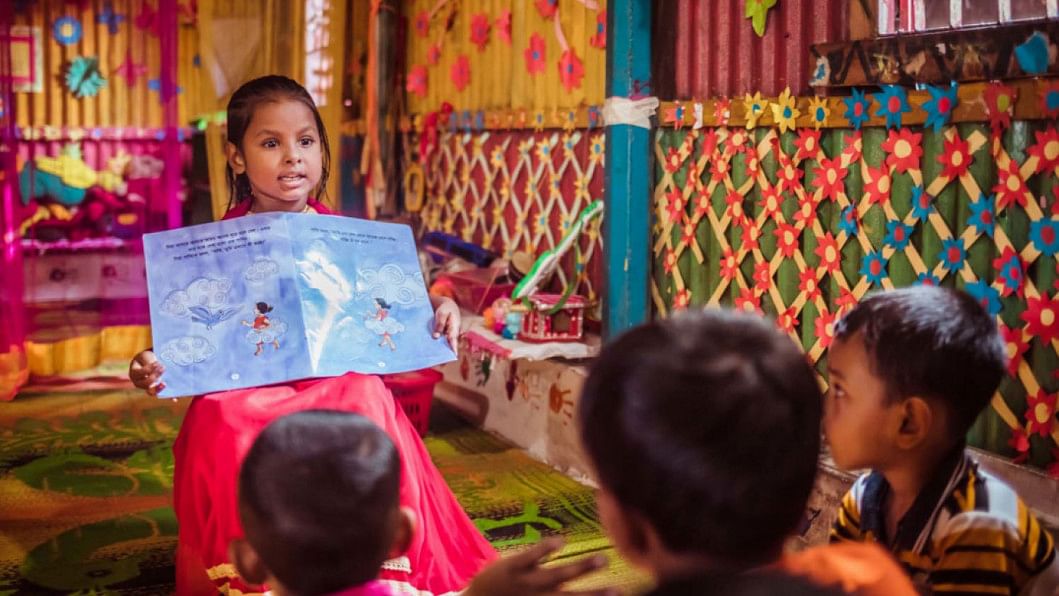Bridge schools: A local solution to a global problem

Over the previous decade, Bangladesh and India achieved 80 percent completion of the primary education cycle (Grades 1 to 5). That is quite an improvement from previous decades, but there are still a lot of children who are not completing primary school and hence not enrolling in secondary school. Adding to these challenges, the Covid-19 pandemic has thrown a significant number of children out of school.
Over the last five years, Brac has undertaken an ambitious pilot project to reintegrate over 70,000 children in 2500 one-room schools. These children had completed Grade 1 or 2 before dropping out. "Bridge schools," as they are called, offer an intensive bridging course of four months and use a compressed curriculum, which enables children to continue their education and complete Grade 5 in a shorter amount of time.
The first version of bridging schools is coming to its end; and a second version has already been launched. As part of our review of the first version, we conducted a survey of a statistically representative group of children in Grades 4 and 5, from randomly-selected schools across Bangladesh. The survey took place in the students' homes, not in the schools.
There are five elements in any working school system: 1) a well-designed curriculum; 2) capable teachers; 3) frequent student evaluation with feedback; 4) students' eagerness to learn; and 5) family members helping students. For a school to succeed, all five of these elements need to be in place and operative. During the survey, we posed many questions on teacher/family interaction, children's attitude towards the Bridge school, why he or she dropped out of a previous school, etc. In focus groups, we gathered teachers' responses.
In its latest education intervention, Bridge school has strived to improve the five elements – with a compressed curriculum, innovations for teachers to overcome school closure due to Covid, and more teacher-guardian interaction. The four-month bridging course worked as an excellent diagnostic tool for Brac to introduce appropriate remedies for students' problems. The result has been better learning outcomes of Bridge school students relative to comparators in India. The current global learning crisis is of grave concern to the World Bank, Unicef, and other multilateral and bilateral organisations. A local solution like the Bridge school can make a major contribution to minimising it.
Public and private education systems around the world, especially in developing countries, focus mainly on regular students and neglect those who have never enrolled or have dropped out. The Covid-19 pandemic forced temporary school closure and kept 1.6 billion children out of school for various durations. Globally, an estimated 72 million children will be added to the already 382 million "learning poor" children. The learning poverty report estimates a USD 10 trillion loss in labour earning over the working lives of the children now in school. This loss is approximately 10 percent of the global annual GDP. A model like Bridge can minimise learning loss by bringing children back to school, improving learning outcomes, and building foundational literacy and numeracy skills.

Important as the five elements are, if children are not learning, schools are failing. To assess the two core subjects, reading and arithmetic, we adopted a protocol named the Annual Status of Education Report (ASER), developed by Pratham, an Indian NGO. Pratham has conducted surveys on five lakh children throughout India for over a decade. Using ASER enabled us to compare Bridge results with results from Indian schools. The most demanding reading test is a student's ability to read a short story with few errors. The most demanding arithmetic question is one's ability to divide a three-digit number by a one-digit number.
Including students across all Indian school types, in 2018 (the last pre-Covid ASER survey), 50 percent of children could read the short story and 28 percent could do the division. And in the Brac Bridge school survey, 53 percent students could read the story and 63 percent were able to do the division.
Though we would have liked better results from Bridge students, on average, children in Bridge schools performed better than the average Indian student, and performed significantly better than children attending Indian government schools. Furthermore, the typical Bridge student faces more serious obstacles than the average Indian student. Bridge children have had interrupted school careers and low family income. And due to Covid, their schools often remained closed during the last two years. To their credit, Bridge teachers adapted and were able to teach classes using mobile phones.
In trying to determine which children were more likely to succeed in reading and arithmetic, the most important factor was the frequency of teachers visiting students' homes. Teacher visits, parental literacy, and family income are relevant in combination. After adjusting for these factors, another factor looms large – where students live. In some upazilas, over 80 percent of students successfully read the short story and did the division; in other upazilas, fewer than 40 percent succeeded. This spatial inequality can be reduced by revitalising the aforementioned five elements. Thus, Bridge schools can be replicated in other parts of the world where school dropouts and learning poverty are severe crises.
Stephen Heyneman is professor emeritus at Vanderbilt University in the USA. Shahidul Islam is an education policy researcher in Canada. John Richards is professor at Simon Fraser University in Canada.

 For all latest news, follow The Daily Star's Google News channel.
For all latest news, follow The Daily Star's Google News channel. 







Comments